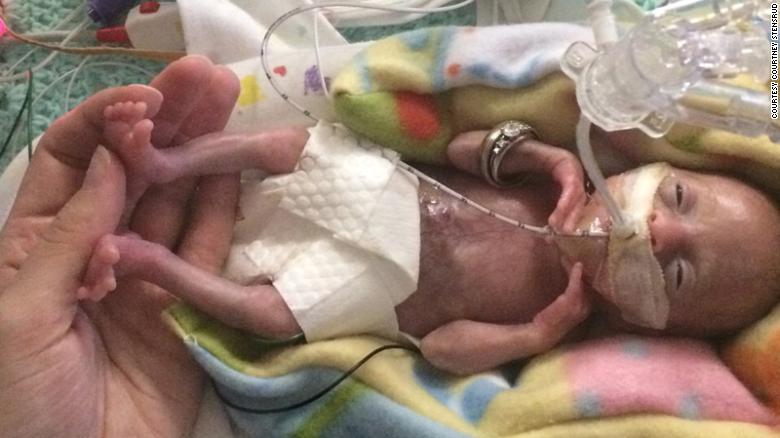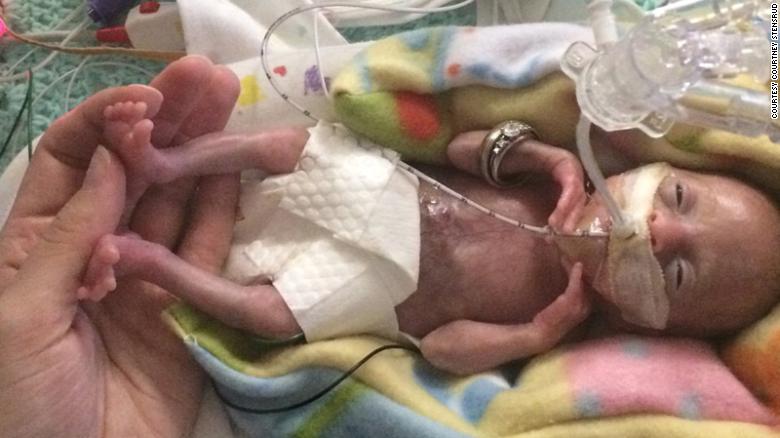When we argue about pro-life vs. pro-choice it can be easy to lose sight of what we’re even arguing about. It’s so easy to want to be right that winning becomes more important than knowledge. We forget the people we are even “fighting” for.
That’s why I love this story. It reminds me that there are names and faces and families we are standing up for.
Courtney Stensrud and her husband are another case that show just how alive babies are in the womb.
Their daughter has set a record. The now 3-year-old was born at just 21 weeks, making her one of the most prematurely born babies to survive, according to a case published in the journal Pediatrics.
Having a baby prematurely is one of any mom’s greatest fears. Even with all the medical advancements we enjoy today, babies born younger than 22 weeks have a very low chance of survival. But sometimes medical emergencies necessitate an early birth, and that was Courtney’s story. In the hospital just before her daughter’s birth, she searched online to see if any other mothers had given birth at 21 weeks.
“There were stories of 22-weekers, 23-weekers, but nothing about 21-weekers. So I knew that there was little to no survival or viability at 21 weeks,” said the stay-at-home mom, now 35.
Just after the birth, Dr. Kaashif Ahmad, a MEDNAX-affiliated neonatologist at the hospital and lead author of the case report, told her that her baby had an extremely low chance of survival and even suggested that they shouldn’t resuscitate the baby.
Courtney listened while holding her less than 2 lb baby girl in her arms and said:
“Although I was listening to him, I just felt something inside of me say, ‘Just have hope and have faith.’ It didn’t matter to me that she was 21 weeks and 4 days. I didn’t care,” she said. “I just said, ‘Will you try?’ And he said he would, and three years later, we have our little miracle baby,” Courtney said.
“I don’t tell her story a lot, but when I do, people are amazed,” she said. “If there’s another woman in antepartum that is searching Google, they can find this story and they can find a little bit of hope and a little bit of faith.”
“We have to be very cautious about generalizing one good outcome to a larger population,” Ahmad said.”It is very possible that there have been many 21-week babies resuscitated in other places that did not have positive outcomes, and for that reason, we haven’t heard about them,” he said. “We reported this case because after this resuscitation she did well, but it may be possible that this is just an extraordinary case and that we shouldn’t expect the same from other babies. We have to learn more before we can make any conclusions.”
An estimated 15 million babies are born too early every year according to the World Health Organization.
In 2016, preterm birth affected about one of every 10 infants born in the United States, according to the Centers for Disease Control and Prevention.
Guidelines put out by the pediatric and obstetric professional society are consistently updated to redetermine when resuscitating a preterm baby should be recommended or not. The constant question is, “When is a baby too young to be resuscitated?”
Ahmad is hopeful that this case will start a greater pursuit for the right answer. Courtney’s baby spent 126 days in the NICU after being born.
Initially, Dr. Ahmad and his colleagues weren’t expecting to resuscitate the baby. “But when the mother asked that we do everything for her daughter, despite having no reason to believe the baby would survive, I just made the decision to proceed with a vigorous resuscitation,” Ahmad said.
“So we placed her under an overhead warmer, we listened, and we heard her heart rate, which we were not necessarily expecting,” he said. “We immediately placed a breathing tube in her airway. We started giving her oxygen, and really pretty quickly, her heart rate began to rise. She very slowly changed colors from blue to pink, and she actually began to move and began to start breathing within a few minutes.”
A lot of preterm babies struggle with growth, but by two years old, Courtney’s daughter achieved scores that were average for a child around 20 months.
“For this little girl, we say that her fine motor was age equivalent to 20 months,” Ahmad said. “That is what we would expect the average 20-month baby to do,” he said. “She was at that time 24 months, but as we noted in the case, if you take into account how many weeks early she was, she was actually about 20 months, corrected.”
She has no auditory or visual impairments and now attends preschool.
“If you didn’t know that she was so preemie, you would think she’s a normal 3-year-old,” Stensrud said. “In her school, she is keeping up with all the other 3-year-olds. She loves playing with other kids. She loves everything I think a normal 3-year-old likes. She loves her baby dolls, she loves books, and she loves make-believe. She loves anything and everything her (older) brother is doing.”
The survival rate for preterm babies has been increasing. According to the New England Journal of Medicine the survival rate has grown from 30% to 36%.
We’re grateful for the incredible medical advancements that help preterm babies survive after early birth. Stories like these demonstrate why 20 week abortion bans are not extreme; if babies can survive at a growing rate outside the womb at 21-22 weeks, then we believe doctors should do everything possible to help save them and protect their lives.
Let’s be a nation that celebrates these stories and encourages future medical progress aimed at preserving life!














